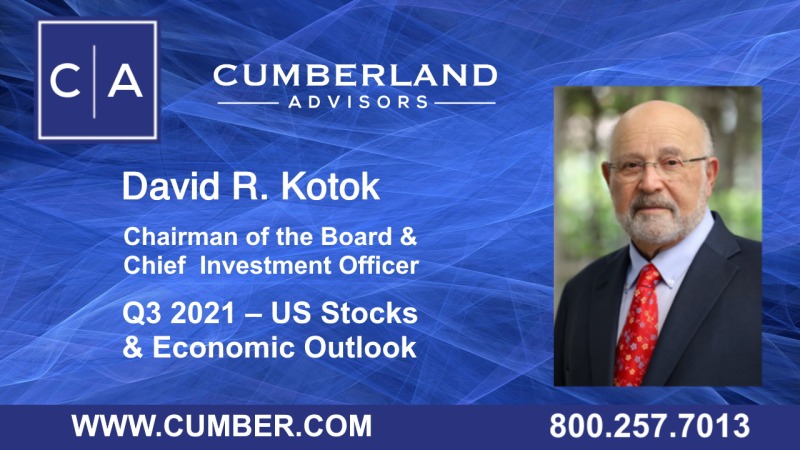Two factors influenced the US stock markets in Q3. They are the Delta variant and tapering (Fed policy). They’re related.

Delta is a national disaster among unvaccinated persons, including schoolchildren and young adults. Its deadliness proves that COVID is not just an old person’s disease. As Q3 unfolded, Delta became an intensifying economic shock of still undetermined proportions. US economic growth is slowing rapidly, and forecasters are revising their Q4 outlooks downward. Some forecasts are down to zero growth in Q4 as Delta sweeps through the unvaccinated population state by state and county by county. In Florida, a Delta peak has been projected after about 8000 official COVID deaths in Q3.
The Fed is delaying asset-purchase tapering because it cannot yet estimate the size of the developing shock until Delta deaths, hospitalizations, and impacts are assessed; so the Fed must wait. Remember Delta is an economic and financial shock and not just a disease shock.
Stock market uncertainty premia rise in a multi-shock scenario. As September closes the quarter, US Equity ETF portfolios are defensively positioned with some cash reserves and an overweighted healthcare sector, coupled with an overweight in climate-change-sensitive ETFs. Note that portfolio changes may occur at any time as circumstances change.
The evidence about a rapid deterioration in labor force participation mounts as incoming information confirms that Delta-induced fear is influencing US labor force participants’ behaviors. On September 15, the Conference Board (https://conference-board.org/us/) emailed an analysis, “As Delta Surges, Four in 10 Workers Fear COVID-19 Exposure.” Their survey found that 42% of workers feared exposure to the virus and the possibility that they might infect their families, while one third worried about coworkers’ failure to adhere to safety guidelines. They broke down responses to a range of questions by gender and generation and found that a higher percentage of women than men and a higher percentage of Millennials than Gen-Xers or Baby Boomers were concerned about exposure to the virus, along with the possibility of infecting their family members, and reported pressures to get back to work and “deterioration of mental health.”
The issue of fear and employment has been examined in a multi-country research study by David Blanchflower and Alex Bryson. See “The Economics of Walking About and Predicting Unemployment,” https://www.nber.org/papers/w29172. Their pioneering work examines causality between sentiment or fear indicators and economic output or employment (or unemployment). Subsequent research is underway to examine the issue at a state level in the US.
Early indications suggest that a state’s COVID policy (or lack of one) impacts that state’s economic recovery program. States which follow strong anti-COVID mitigation do better and recover more robustly. States with weak public health policy may think that they are pro-business, but the evidence mounts that those “open up” political policies result in slower recovery and weaker economic growth. Based on the information we’ve seen so far, we expect the weakness in outcomes to show up dramatically in states that have low percentages of their populations vaccinated, fewer people masking to slow spread of the virus, and thus more sickness and more deaths. We’re tracking all 50 states as data becomes available.
We expect Delta to burn through the unvaccinated population, including the unvaccinated school age cohort, with negative economic results. If the preliminary work of Blanchflower and Bryson turns out to be close to correct, the US labor force statistics for autumn are likely to be ugly.
After this quarterly missive was drafted the market gyrations about Evergrande and China made headlines worldwide. So far, there is no visible contagion in the rest of the world. We’re watching the global GSIB banks for warning signs. As of this writing, none have appeared.
With regard to vaccines, herd immunity, and other COVID-related issues, we offer five curated readings. They follow below. Please remember that our portfolio management positions may change at any time.
“The tangled history of mRNA vaccines,”
https://www.nature.com/articles/d41586-021-02483-w
“Risk prediction of COVID-19 related death and hospital admission in adults after COVID-19 vaccination: national prospective cohort study,”
https://www.bmj.com/content/bmj/374/bmj.n2244.full.pdf
“England Enjoys COVID-19 Herd Immunity Benefits,”
https://www.precisionvaccinations.com/england-enjoys-COVID-19-herd-immunity-benefits
“More Measles Cases Confirmed by the U.S. CDC,”
https://www.precisionvaccinations.com/2021/09/16/more-measles-cases-confirmed-us-cdc
“Daily testing for contacts of individuals with SARS-CoV-2 infection and attendance and SARS-CoV-2 transmission in English secondary schools and colleges: an open-label, cluster-randomised trial,”
https://www.thelancet.com/journals/lancet/article/PIIS0140-6736(21)01908-5/fulltext
David R. Kotok
Chairman of the Board & Chief Investment Officer
Email | Bio
Links to other websites or electronic media controlled or offered by Third-Parties (non-affiliates of Cumberland Advisors) are provided only as a reference and courtesy to our users. Cumberland Advisors has no control over such websites, does not recommend or endorse any opinions, ideas, products, information, or content of such sites, and makes no warranties as to the accuracy, completeness, reliability or suitability of their content. Cumberland Advisors hereby disclaims liability for any information, materials, products or services posted or offered at any of the Third-Party websites. The Third-Party may have a privacy and/or security policy different from that of Cumberland Advisors. Therefore, please refer to the specific privacy and security policies of the Third-Party when accessing their websites.
Cumberland Advisors Market Commentaries offer insights and analysis on upcoming, important economic issues that potentially impact global financial markets. Our team shares their thinking on global economic developments, market news and other factors that often influence investment opportunities and strategies.

